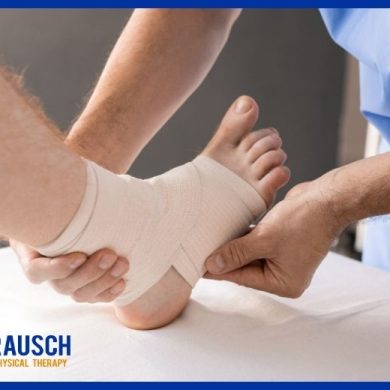At Rausch Physical Therapy and Wellness, we believe that movement is medicine—at every age and every stage of life. That’s why we’re excited to announce our new partnership with Fort Fitness,
Understanding Frozen Shoulder and How to Fix It
October 9, 2015 8:27 pm / Category: Physical Therapy
A question that I commonly hear from patients with shoulder pain (and access to Google) is, “What is frozen shoulder?” The truth is, “frozen shoulder” is a common term that’s thrown around, but few people understand the condition or its causes.
What is “Frozen Shoulder?”
The medical term for frozen shoulder is “Adhesive Capsulitis,” and it effects the joint capsule of the shoulder. Every joint within the body contains a capsule surrounding it to provide structural stability; the shoulder joint is special in that it’s one of the most mobile joints in the body, which consequently requires a great deal of ligamentous (capsule) and muscular support to stabilize it.
Like all tissues within the body, the shoulder capsule will attempt to repair itself if damaged, going through the three phases of tissue regeneration: inflammation (swelling), proliferation (scar-tissue), and remodeling.
However, Adhesive Capsulitis is an abnormal inflammatory response; basically, the shoulder thinks it’s damaged, so it sends an unnecessary amount of new collagen (i.e. scar tissue) to the joint. This transforms the typically-mobile shoulder joint into a thick and adhesive one, which ultimately leads to pain and loss of mobility.
Signs You May Have Frozen Shoulder
While a stiff, painful shoulder could be caused by a number of things, many patients or their doctors will incorrectly diagnose it as frozen shoulder. However, the number one indicator that you truly have a frozen shoulder is if there’s a significant decrease in external rotation, especially compared to your other arm. Some other common symptoms include:
- Significant decrease in range of motion, especially loss of external rotation (ability to life your arm overhead)
- Gradual onset of pain lasting at least one month
- Progressive pain in the shoulder that worsens and is not relieved at rest
- Pain that interrupts sleep and/or makes it impossible to sleep on affected side
Again, it’s important to note that these symptoms can also be indicative of other shoulder issues, so you should have your physician or physical therapist do an evaluation to find out the true cause to ensure you get the proper treatment.
Causes of Frozen Shoulder
There are currently two categories of Adhesive Capsulitis, Primary Adhesive Capsulitis and Secondary Adhesive Capsulitis. Primary affects between 2% to 5.3% of the general population and has no known cause; it’s only characterized by a subtle and gradual onset that worsen over time and then resolves, usually within one to three years.
Secondary Adhesive Capsulitis is more common, affecting between 4.3% to 38% of the general population. It occurs in people who have incurred trauma or impingement to the shoulder, or who have had to immobilize their shoulder for a long period, such as after surgery or injury. People who have systemic complications, such as Thyroid Disease or Diabetes Mellitus, are also at risk.
While doctors aren’t sure why this happens to some people, it is more common to occur in:
- People 40 and older, particularly women
- People who have had a previous episode of Adhesive Capsulitis in the opposite shoulder
- People who have concurrent systemic complications (i.e. Thyroid Disease, Diabetes Mellitus, Parkinson’s Disease, etc.)
Stages of Frozen Shoulder and Their Symptoms
Due to the naturally-occurring inflammatory condition of Adhesive Capsulitis, it’s important to understand which stage of “Frozen Shoulder” you’re in so you can make sure you get the appropriate treatment.
[one_third]
Stage 1: Freezing
Key indicator is pain with movement and at rest
Usually lasts for three to nine months
Gradual loss of motion in all directions
[/one_third]
[one_third]
Stage 2: Frozen
Characterized by pain with movement
Usually lasts for nine to 15 months
Inflammation of the joint capsule begins to lessen
[/one_third]
[one_third_last]
Stage 3: Thawing
Characterized by resolution of pain with residual stiffness
Usually lasts 15 to 24 months after onset
[/one_third_last]
Top Three Ways to Treat Frozen Shoulder
Depending on which stage you are in, the treatment for Adhesive Capsulitis can vary. Here are three of the most common and effective treatments for regaining a full, pain-free range of motion.
1. Take Anti-Inflammatory Medication
Because of this condition’s correlation with join inflammation, coupled with its gradual progressiveness, inflammatory medication (such as Advil, Motrin IB, etc.) can help relieve pain. For more severe cases, a cortisone injection (a localized injection of an anti-inflammatory medication) is available; consult with your primary care physician or physical therapists about this option.
2. If You’re in Pain: Modify Your Activity
During the painful freezing stage, you should modify the way you move throughout your day to help reduce the amount of irritation and inflammation to the joint. If a certain movement, such as reaching to grab a dish or swinging a tennis racket, causes a significant increase in pain, avoid it.
3. If You’re Just Stiff: Stretch It Out!
Once you’ve progressed into the thawing stage and can lift your arm without pain, then it’s time to start aggressively stretching out that shoulder! Since the shoulder capsule is comprised of dense connective tissue, it requires a prolonged stretch (five to 10 minutes) to create a lasting change in tissue length. As long as you are just feeling tightness/stiffness, NOT pain, then keep stretching. Research has shown that improving external rotation can improve motion in all directions and help get you pain free.
If you’re unsure, come visit us here at Rausch Physical Therapy; we can evaluate your particular and come up with a great home exercise program to get you back to pain-free movement.

Click to learn more about Sean and our other physical therapists >>





